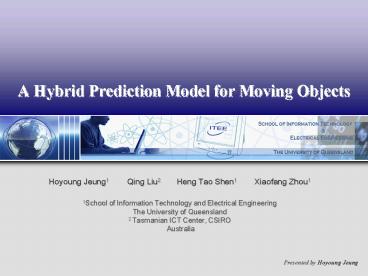A Hybrid Prediction Model for Moving Objects - PowerPoint PPT Presentation
1 / 23
Title:
A Hybrid Prediction Model for Moving Objects
Description:
Bike: real, from GPS mounted bike. Cow: real, from GPS ear tags. Car: real, from GPS equipped car ... Query response time Performance of TPT. Conclusion ... – PowerPoint PPT presentation
Number of Views:64
Avg rating:3.0/5.0
Title: A Hybrid Prediction Model for Moving Objects
1
A Hybrid Prediction Model for Moving Objects
- Hoyoung Jeung1 Qing Liu2 Heng Tao
Shen1 Xiaofang Zhou1 - 1School of Information Technology and
Electrical Engineering - The University of Queensland
- 2 Tasmanian ICT Center, CSIRO
- Australia
Presented by Hoyoung Jeung
2
(No Transcript)
3
Prediction in Moving Objects Databases
- Moving Objects Databases
- Model an objects positions ? function of time
- Reduce the frequency of location updates
- More effective to express continuous movements
- All locations in MOD ? estimated (predicted)
- Prediction models
- Linear
- Non-linear
4
Limitations of Existing Prediction Models
- Only for near future
- A location at noon from 9 am movements?
- Even for near future
- Mathematic formulas cannot represent preferred
movements
5
Motivation
work
820 am (Factory)
900 am
800 am (Home)
If the current movements are (home,800),
(factory,820) and a 900 am location is asked
3 days trajectory
We can say it is likely to be at work
6
Problem Formulation
- Given an object's trajectory l0, l1, , ln-1,
where li denotes a
d-dimensional location at time i ,
discover the objects trajectory
patterns P of the form - Given the object's h most recent movements
- l0, l1,, lh-1, and the query time tq,
- estimate the object's future location lq
using P
7
Overview
8
Detection of Frequent Regions
- Decomposing a whole trajectory into
sub-trajectories - Grouping positions at time offset k in each
sub-traj. - Applying a clustering method
9
Discovery of Trajectory Patterns
- Note
- Applied and modified Apriori to prune rules
- Contradicting the temporal order (e.g.,
) - Multiple items in the consequence (e.g.,
)
10
Trajectory Pattern Tree
- A variant of the Signature-tree Mamoulis ICDE03
- Different leaf nodes, novel encoding of
signatures
11
Encoding Trajectory Patterns
- Pattern key Premise key Consequence key
- Region key table
12
Encoding Trajectory Patterns (cont.)
- Consequence key
- Pattern key
13
An Example of Searching
- Given query recent movements ,
- Query pattern key q 1000011
1000011
1000011
1000011
1000011
1000011
1000011
14
The Hybrid Prediction Algorithm
- If no pattern at tq?
- If patterns at tq?
- Distance time query / non-distance time query
15
Query Processing Near Future
- Forward algorithm ( When )
- An object is likely to follow the trend of recent
movements - Candidate filtering
- Ranking candidates
- Sim(the current movements, the premise of each
pattern) x confidence - Current movements are more important
16
Premise Similarity Measure
101101
- Ranking candidates
17
Query Processing Distant Future
- Backward algorithm ( When )
- The recent movements are not so important for
prediction - Candidate filtering
- Ranking candidates
- ( Sim(premise) x penalty Sim(consequence) ) x
confidence - As the query time , the importance of recent
movements
18
Datasets
- Generated 4 multiple traj. based on single ones
- Bike real, from GPS mounted bike
- Cow real, from GPS ear tags
- Car real, from GPS equipped car
- Airplane synthetic from real
- Performance Comparison
- The Hybrid Prediction Model (HPM)
- Recursive Motion Function (RMF)
19
Results - Prediction Accuracy
- Change along prediction length
Change along num. sub-trajectories
20
Results - Effect of Discovery Parameters
- Eps
MinPts (minimum support) - Pruning power
Minimum confidence
21
Results Query Cost
- Query response time
Performance of TPT
22
Conclusion
- Proposed a new prediction model for moving
objects - Defined, discovered, and indexed trajectory
patterns - Introduced the hybrid prediction algorithm
- HPM is more accurate and efficient than
state-of-the-art
23
Thank you































